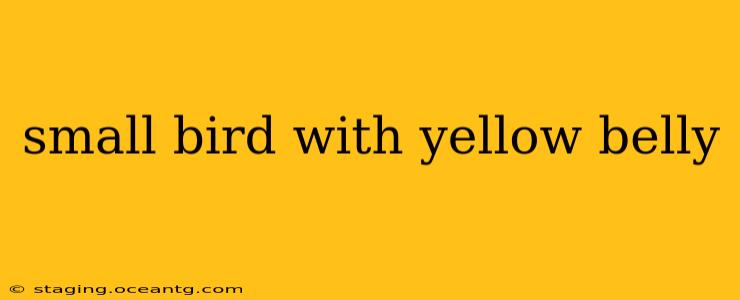Spotting a small bird with a yellow belly can be exciting! Many species boast this vibrant feature, making identification a fun challenge. This guide will help you narrow down the possibilities, exploring common characteristics and regional variations. Let's dive into the world of yellow-bellied birds!
What are some common small birds with yellow bellies?
This question depends heavily on your geographic location. The species you're likely to encounter will vary drastically between North America, Europe, Asia, and Australia. However, some common characteristics across multiple species include size (generally smaller than a robin), the presence of yellow on the belly (which might extend to the breast or flanks), and other distinctive markings such as wing bars, head patterns, or beak shape. Some examples include:
-
American Goldfinch (North America): A tiny, vibrant bird with a bright yellow belly, especially in breeding season. Males are more intensely colored. Their flight is distinctive and undulating.
-
Yellow Warbler (North America): These warblers are known for their bright yellow plumage, with varying degrees of chestnut streaks on the breast.
-
Yellow-rumped Warbler (North America): While the yellow is primarily on the rump (rear), they often show yellow on their underparts, particularly in certain subspecies.
How can I identify a small bird with a yellow belly?
Identifying any bird requires careful observation. Here's a step-by-step approach:
1. Note the Location:
Where did you see the bird? Your geographic location drastically narrows down the possibilities. Are you in a forest, field, backyard, or near water? Different habitats attract different bird species.
2. Observe Size and Shape:
How big is the bird relative to other familiar birds? Is it plump or slender? The overall shape can be a key identifier.
3. Examine the Plumage:
Beyond the yellow belly, what other colors are present? Are there streaks, spots, or other markings? Note the color of the head, back, wings, and tail. Pay attention to the beak shape - is it long, short, thick, or thin?
4. Consider Behavior:
How did the bird move? Did it hop, flutter, or glide? What was its foraging behavior? Did it seem to favor certain food sources?
5. Use a Field Guide or Bird Identification App:
Armed with your observations, consult a field guide specific to your region or use a bird identification app (like Merlin Bird ID or eBird) with image uploads for more accurate identification.
What is the best way to attract small birds with yellow bellies to my backyard?
Attracting specific bird species requires providing resources they need for survival. Consider these measures:
-
Provide food sources: Offer seeds (such as niger seeds for goldfinches), suet, or nectar feeders.
-
Offer water: A birdbath or shallow dish of water is crucial, especially during hot weather. Consider a gently moving water feature for added attraction.
-
Plant native vegetation: Native plants provide shelter, nesting sites, and food sources specific to your local bird species.
-
Provide suitable nesting sites: Consider adding nesting boxes in appropriate locations.
Are there any rare birds with yellow bellies?
Rarity depends heavily on location. While some birds with yellow bellies are relatively common, others may be less frequently seen, often due to their specific habitat requirements or limited range. To determine rarity, it is best to check with local ornithological societies or birdwatching groups.
What do small birds with yellow bellies eat?
The diet of a small bird with a yellow belly will heavily depend on the species. They may consume seeds, insects, nectar, fruits, and berries. Observing their foraging behavior can offer clues about their preferred food sources.
By carefully observing the bird and using available resources, you can significantly increase your chances of identifying your yellow-bellied visitor! Remember, accurate identification requires patience and detailed observation. Happy birding!
